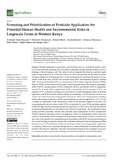Screening and Prioritization of Pesticide Application for Potential Human Health and Environmental Risks in Largescale Farms in Western Kenya

View/
Date
2023-05-31Author
Onyando, Zedekiah Odira
Omukunda, Elizabeth
Okoth, Patrick
Khatiebi, Sandra
Omwoma, Solomon
Otieno, Peter
Osano, Odipo
Lalah, Joseph
Metadata
Show full item recordAbstract
Pesticide application in agricultural and residential areas is a worldwide practice. However, human pesticide poisoning and environmental pollution through pesticide residues remain a challenge in the developing world. The present study investigated the intensity of pesticide application in large-scale farms in Trans-Nzoia County to screen and prioritize the pesticides for potential human health and environmental risks. A cross-sectional survey involving 348 farmers was conducted in the study area, and data was analyzed using SPSS. Environmental Exposure Potential (EEP) and Toxicity Potentials (TP) were analyzed from the Pesticide Properties Database (PPDB). Majority (99.4%) of the farms surveyed apply various pesticide classes that include: organophosphates (34.78%), neonicotinoids (15.22%), carbamates (10.87%), pyrethroids (10.87%), organochlorines (8.7%), triazoles (6.5%), copper-based (4.34%), avermectines (2.17%), triazines (2.17%), and amidines (2.17%), with the use of organic manures (26.3%). Despite the high prevalence of pesticide application, only 48.28% of farms conduct soil quality monitoring, 77.3% of whom do not have clear records and schedules for conducting periodic soil analyses. There was a strong positive correlation between the acreage of operation and the use of herbicides in weed management (r = 0.77; p ≤ 0.05). In relation to degradation in the environment, 18.42% of the pesticides applied in the study area were persistent in soil sub-systems while 31.58% are persistent in water. Of the pesticides applied, 18.42% had high chances of bioconcentration in living tissues, 10.53% and 13.16% had the potential of contaminating groundwater and surface water resources, respectively. The ranked-order human toxicity potential associated with the used pesticides were teratogenicity (31.58%), neurotoxicity (28.95%), endocrine disruption (7.9%), carcinogenicity (7.9%), and mutagenicity (2.63%). However, 10.53% of the pesticides possess multiple toxicity potentials. Some farmers (53.70%) surveyed were not aware of the negative environmental impacts of pesticides with 59.50% having prior training on the use and handling of pesticides. Despite the availability of Personal Protective Equipment (PPEs) on larger farms, 31.9% of the farm workers do not adhere to their use during pesticide application. In conclusion, there is low awareness among farmers of human health and environmental risks associated with pesticide application. The study recommends training of farm managers, farm owners, and farm workers on pesticide handling and associated health and environmental effects.
URI
https://doi.org/10.3390/agriculture13061178https://www.mdpi.com/2077-0472/13/6/1178
http://ir-library.mmust.ac.ke:8080/xmlui/handle/123456789/2229
Collections
- Gold Collection [1026]
